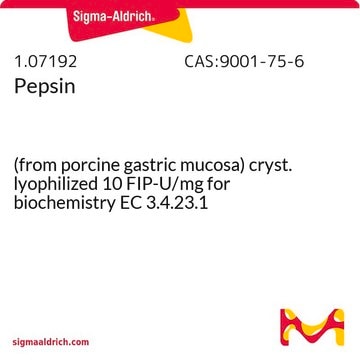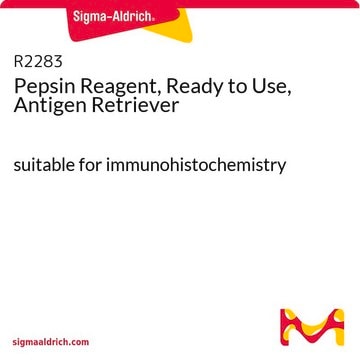10108057001
Roche
Pepsin
lyophilized (salt-free), ~2500 units/mg protein (At 37 °C with hemoglobin as the substrate. One unit is the enzyme activity which liberates the amount of Tyr producing an increase in the absorbance of 0.001/minute at 280 nm.)
Synonyme(s) :
pepsin
Se connecterpour consulter vos tarifs contractuels et ceux de votre entreprise/organisme
About This Item
Produits recommandés
Source biologique
pig gastric mucosa
Niveau de qualité
Forme
lyophilized (salt-free)
Activité spécifique
~2500 units/mg protein
Conditionnement
pkg of 1 g
Fabricant/nom de marque
Roche
pH optimal
1.8-2.2
Conditions d'expédition
wet ice
Température de stockage
2-8°C
Description générale
Pepsin is an aspartic endoproteinase isolated from pig gastric mucosa. It is mainly used for the unspecific hydrolysis of proteins and peptides in acidic media. It also provides a limited hydrolysis of native immunoglobulins to yield biologically active fragments.
Spécificité
Aspartic endopeptidase with relatively broad specificity. Preferential cleavage: hydrophobic, preferably aromatic, residues in P1 and P1′ positions.
Application
Pepsin has been used for the digestion of liver tissue obtained from rat.
Notes préparatoires
Working concentration: 0.05 to 0.5 mg/ml
Storage conditions (working solution): A pepsin solution is stable at 2 to 8 °C, at least for one week, at neutral pH and under germfree conditions. Frozen aliquots of the enzyme solution are expected to be more stable.
A stock solution in 10 mM HCl (5-10 mg/ml) should be stable for at least one week at 2 to 8 °C, too. Storage light protected, tightly closed.
A short (2 minutes) incubation at 40 °C has negligible effect on the activity of lyophilized pepsin or pepsin in solution.
Storage conditions (working solution): A pepsin solution is stable at 2 to 8 °C, at least for one week, at neutral pH and under germfree conditions. Frozen aliquots of the enzyme solution are expected to be more stable.
A stock solution in 10 mM HCl (5-10 mg/ml) should be stable for at least one week at 2 to 8 °C, too. Storage light protected, tightly closed.
A short (2 minutes) incubation at 40 °C has negligible effect on the activity of lyophilized pepsin or pepsin in solution.
Remarque sur l'analyse
At 37 °C with hemoglobin as the substrate. One unit is the enzyme activity which liberates the amount of Tyr producing an increase in the absorbance of 0.001/minute at 280 nm.
Autres remarques
For life science research only. Not for use in diagnostic procedures.
Mention d'avertissement
Danger
Mentions de danger
Conseils de prudence
Classification des risques
Eye Irrit. 2 - Resp. Sens. 1 - Skin Irrit. 2 - STOT SE 3
Organes cibles
Respiratory system
Code de la classe de stockage
11 - Combustible Solids
Classe de danger pour l'eau (WGK)
WGK 1
Point d'éclair (°F)
Not applicable
Point d'éclair (°C)
Not applicable
Faites votre choix parmi les versions les plus récentes :
Déjà en possession de ce produit ?
Retrouvez la documentation relative aux produits que vous avez récemment achetés dans la Bibliothèque de documents.
Les clients ont également consulté
Lauren M Ashwood et al.
BMC biology, 21(1), 121-121 (2023-05-25)
The ShK toxin from Stichodactyla helianthus has established the therapeutic potential of sea anemone venom peptides, but many lineage-specific toxin families in Actiniarians remain uncharacterised. One such peptide family, sea anemone 8 (SA8), is present in all five sea anemone superfamilies.
Marie van Dijk et al.
Prenatal diagnosis, 42(13), 1612-1621 (2022-11-08)
Noninvasive Prenatal Diagnosis has recently been introduced for a limited number of monogenetic disorders. However, the majority of DNA diagnostics still require fetal material obtained using an invasive test. Recently, a novel technique, TRIC (Trophoblast Retrieval and Isolation from the
Ganesan Arunkumar et al.
Science advances, 8(9), eabl5621-eabl5621 (2022-03-03)
Chromosome instability is a critical event in cancer progression. Histone H3 variant CENP-A plays a fundamental role in defining centromere identity, structure, and function but is innately overexpressed in several types of solid cancers. In the cancer background, excess CENP-A
William D Kim et al.
Frontiers in genetics, 13, 1045738-1045738 (2022-11-29)
Mutations in CLN5 cause a subtype of neuronal ceroid lipofuscinosis (NCL) called CLN5 disease. The NCLs, commonly referred to as Batten disease, are a family of neurodegenerative lysosomal storage diseases that affect all ages and ethnicities globally. Previous research showed
Claus Kordes et al.
The Journal of clinical investigation, 124(12), 5503-5515 (2014-11-18)
Retinoid-storing hepatic stellate cells (HSCs) have recently been described as a liver-resident mesenchymal stem cell (MSC) population; however, it is not clear whether these cells contribute to liver regeneration or serve as a progenitor cell population with hepatobiliary characteristics. Here
Notre équipe de scientifiques dispose d'une expérience dans tous les secteurs de la recherche, notamment en sciences de la vie, science des matériaux, synthèse chimique, chromatographie, analyse et dans de nombreux autres domaines..
Contacter notre Service technique










